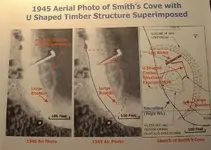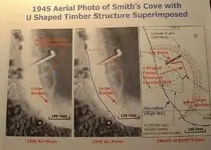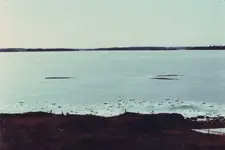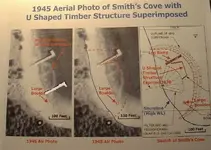gazzahk
Bronze Member
- Joined
- Nov 14, 2015
- Messages
- 1,720
- Reaction score
- 2,584
- Golden Thread
- 0
- Primary Interest:
- All Treasure Hunting
D.Kings article is just rubbish. It has zero evidence to support it and is just a collection of wild assertions and claims. He even goes on to conclude that his theory would not work if it rained…
Take a look at the rainfall statistics for Oak island
There is nothing that has been found that supports his view. Not one historian/treasure seeker that has written about OI gives this article any mention/credience at all.
As posted before here are some comments on specific pieces of his article..
Here is an extract from his article..
If this was his theory this would suggest that after each tide they now had to dig up the sand on the beach to get the salt form it. Why would the salt be concentrated on the sand? This is the method that he is basing his theory on. (But later goes on to say it was not done this way and comes up with his own theory which is not based on any other salt making method that he quotes as examples)
D.King himself argues that no solar evaporation of the water was being done to help produce the salt being done on OI
As to this argument
D.King next statement is now a complete NEW method of alleged salt making and is not based on any other method ever used
As shown from this source
referencing this book: https://books.google.com.hk/books?id=yo_xAgAAQBAJ&redir_esc=y&hl=en
This setup would give that beach incredible drainage. No salt would sit on the sand as any water would drain Away as soon as the tide went out.
This just seems totally without any logic and in contradiction to things said earlier in the article.
Also he's speculations about rain water do little to support his own theory for the same reason. What evaporation…
I believe the beach was created to dry seafood for the fishing/naval stores/timber etc industry that existed on OI
Here is a picture of fisherman drying fish on the beach in Nova Scotia as was common practice
https://novascotia.ca/archives/dennis/archives.asp?ID=1585
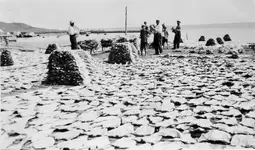
I agree with J.Steeles speculations that the coffer dam was meant to keep Smith Cove dry and something was setup there ie a crane for helping load/unload the ships. The finger drains were to drain out the coffer dammed cove from rain/seepage etc during a high tide. Thus they had to drain the water back onto the island as it would be impossible to drain out to sea at higher tides.. It may even be the sump they found the drains led to was needed to help the industry operating there. Ie a source of close water to put out fires from the tar kilns if the exploded...
Take a look at the rainfall statistics for Oak island
There is nothing that has been found that supports his view. Not one historian/treasure seeker that has written about OI gives this article any mention/credience at all.
As posted before here are some comments on specific pieces of his article..
Here is an extract from his article..
An old historic method of making salt from seawater is described by Professor Le Conte as “lixiviating saline sand and then boiling the brine” (10). He records that salt is made by this method on a small scale in Normandy (he published his work in 1862). The tide is allowed to cover beach sand, which dries after the tide recedes, leaving a mixture of salt and sand. The sand is then removed to sheds, then is transferred to pits where seawater is added. The seawater dissolves the salt in the sand, thus increasing the concentration of salt in the water. The concentrated salt solution is then boiled to extract the salt.
If this was his theory this would suggest that after each tide they now had to dig up the sand on the beach to get the salt form it. Why would the salt be concentrated on the sand? This is the method that he is basing his theory on. (But later goes on to say it was not done this way and comes up with his own theory which is not based on any other salt making method that he quotes as examples)
D.King himself argues that no solar evaporation of the water was being done to help produce the salt being done on OI
He claims that there is a natural saltwater spring. I have seen no evidence of this anywhere else mentioned. What is he trying to suggest that somehow next to OI there is a mysterious source of extra salty sea water. If this was the case then the coffer dam would never be dry as the spring would fill it. Why would the "spring water” be any more salty then the rest of the sea. If this spring was outside the coffer dam then it would simply mix with the ocean. Why has no one mentioned this salt water spring?Because of the relatively cold climate of maritime Canada, producing the salt by solar evaporation was not feasible. The only way to manufacture salt economically on Oak Island was to concentrate seawater by one of the known processes used before the 1800s, and then boil the concentrated salt solution.
As to this argument
There is no explanation as to why this process would concentrate salt on the beach. There would have to be at least 5-7 foot of water allowed into the dam to get to the top of the beach. This would mean any salt sand would just be exactly the same as the sea water... Why would water that dripped to the drains be anything other than just sea water? The drains were meant to be covered with flat rocks so how would the water drip into them anyway? Why would sea water that was not directly over the drains drip into the drains rather than just flow back out to sea when the tide went down? How would those drains catch saltwater form the parts of the beach that are not near the drains?The natural saltwater spring, and/or controlled amounts of seawater through channels in the dyke, would be allowed to permeate the sand on the artificial beach by capillary action. Wind and sun would dry the sand leaving a mixture of salt and sand. The process would be repeated at regular intervals until there was a considerable quantity of salt in the sand. In the meantime the tides would be kept off the beach by the dyke. Once sufficient salt had accumulated in the sand on the artificial beach, a larger than usual but still controlled inundation of seawater at high tide would be allowed through the dyke, covering the beach and dissolving the salt in the sand as the water dripped through the coconut husk and eel grass layers down through the rocks and through the finger drains to the well. The purpose of the coconut husk and eel grass layers was to sieve out any sand and silt from the concentrated salt solution before it reached the well.
D.King next statement is now a complete NEW method of alleged salt making and is not based on any other method ever used
If fresh sea water is allowed over the beach then the salt concentration on the sand is going to be exactly the same as the sea water it mixes with.Oak Islands salt works where I believe the salt-sand mixture was not moved at all but instead left in situ with the concentrated salt solution being produced by allowing fresh seawater to drain through the salt-sand mixture (dissolving the salt therein on the way) and then through the finger drains to accumulate as a concentrated salt solution in the well.
As shown from this source
Source: https://people.howstuffworks.com/oak-island2.htmBelieving now that the flooding tunnels were connected to the sea, men scoured the island's shores. At an area known as Smith's Cove, they found a fascinating structure. The company built a temporary dam, called a cofferdam, to uncover a large overlay made of coconut husk, 145 feet wide and the length of space between low tide and high tide. Underneath the coconut husk was a layer of beach stones five feet deep. Beneath the beach stones were five finger-drains constructed of flat stones, converging into a single drain. The coconut husk worked as a barrier against sand to allow water into the drains.
However, soon after the company found the mysterious finger drains, a storm hit and destroyed the cofferdam. The company then decided to dig shafts between Smith's Cove and the Money Pit in an attempt to intercept and divert the seawater away from the Money Pit. However, after failing to reach water in this shaft, and after digging several more, the company ran out of funds and gave up.
referencing this book: https://books.google.com.hk/books?id=yo_xAgAAQBAJ&redir_esc=y&hl=en
This setup would give that beach incredible drainage. No salt would sit on the sand as any water would drain Away as soon as the tide went out.
This just seems totally without any logic and in contradiction to things said earlier in the article.
This is a cold climate and this beach has excellent drainage. How would this evaporation occur in seconds?If there was indeed a saltwater spring at Smiths Cove, then the area and depth of the artificial beach was deliberately chosen to be large enough to ensure saltwater from the spring would spread via capillary action over a sufficiently large volume of sand that natural evaporation of the saltwater would be complete before the water got through the layers of coconut husk and eel grass so no water would in fact get through to the well from this source.
Also he's speculations about rain water do little to support his own theory for the same reason. What evaporation…
This is why D.King theory is not even mentioned by any other authors who have studied OI and speculated as to the artificial beach..However, what about rainfall falling on the beach? The depth of the sand (about two feet or 60 centimetres) seems sufficient to ensure that the water from a light to medium shower would evaporate before reaching the coconut and eel grass layers, so no problems. But a heavy downpour would admittedly result in the rainwater seeping right through the artificial beach and into the finger drains and so into the well.
I believe the beach was created to dry seafood for the fishing/naval stores/timber etc industry that existed on OI
Here is a picture of fisherman drying fish on the beach in Nova Scotia as was common practice
https://novascotia.ca/archives/dennis/archives.asp?ID=1585

I agree with J.Steeles speculations that the coffer dam was meant to keep Smith Cove dry and something was setup there ie a crane for helping load/unload the ships. The finger drains were to drain out the coffer dammed cove from rain/seepage etc during a high tide. Thus they had to drain the water back onto the island as it would be impossible to drain out to sea at higher tides.. It may even be the sump they found the drains led to was needed to help the industry operating there. Ie a source of close water to put out fires from the tar kilns if the exploded...
Last edited:




